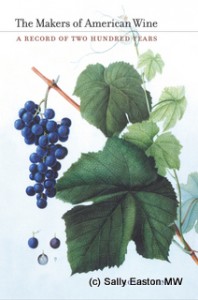The Makers of American Wine
| Title of book: | The Makers of American Wine – a record of two hundred years |
| Author: | Thomas Pinney |
| Publisher: | University of California Press |
| Publication date: | 2012 |
| ISBN | 978 0 520 26953 8 |
| Pages: | 311 |
| Price: | £24.95 / US$34.95 |
 The reader is introduced to the last 200 years of North American, specifically USA, winemaking history through a collection of chapters of luminaries of the USA wine industry.
The reader is introduced to the last 200 years of North American, specifically USA, winemaking history through a collection of chapters of luminaries of the USA wine industry.
Pinney picks the start date of his book as the approximate beginning of commercial wine production in the USA, though the exact date is not known. Vines flourished in North America prior to the earliest European settlers. These were not the vines of Europe but were wild vines which resisted production into palatable wine. Vinifera imports from Europe were the only option, and for two hundred years each swathe of imports failed to embrace American soil, directly because, Pinney says, native American vines flourished. And this is where the history of American vine cultivation differs from that other new world countries, which lacked native vines.
The recognition of chance hybridisation of vinifera and American vines in the early 1800s was a step forward. Persistent among these hybrids are Catawba, Isabella and Lenoir. In the later 1800s adoption of European techniques to combat pests and diseases was another step forward: grafting vinifera onto American rootstocks against phylloxera, spraying sulphur against powdery mildew, Bordeaux mixture against downy mildew.
We learn that West Coast vinous colonisation was a simpler affair as vinifera adopted California with ease from the end of the 18th century, via the early Spanish settlers.
The twelve men and one woman were selected for the book to tell this story because of their evolutionary and problem-solving contributions to the development of the USA wine culture.
It starts with vine specialist Swiss emigrant Jean-Jacques (John James) Dufour who arrived in 1796, and to whom Pinney attributes the kick-starting of serious vinous interest in America.
Pinney cites the mid-nineteenth century Charles Kohler as being the father of the California wine industry, by dint of putting California wine on the map in a lasting way. The German-origin musician-turned-wine man bought a vineyard planted, inevitably, with mission (a grape variety now known to be the old Spanish listán prieto, still surviving on the Canary Islands). Along with friend and fellow musician John Frôhling they formed a wine-growing society to supply their growing need for more wine to sell.
Maynard Amerine merits a place as the partner, with A.J Winkler, who devised, in 1944, the five temperature regions of the state of California, matching grape varieties to temperature zone within California, after spending seven years making batches of wine from different grape varieties grown all over the state.
Pinney, an emeritus professor of English, writes with an effortless and engaging style, so it is all too easy to find oneself reading at leisure. Despite this I suspect this is a book largely for specialists of the USA wine scene, though anyone researching the more recent personalities of USA wine history, including Ernst and Julio Gallo, Robert Mondavi, and Cathy Corison will find a wealth of information detailed here.



